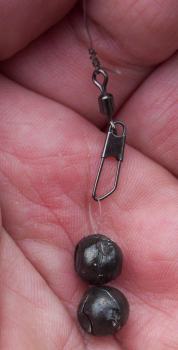Legering is a method of presenting a bait in a stationary position….or is it? Sometimes it is necessary to present baits on the bottom, but in a manner that looks completely natural to the fish the angler is trying to catch. On a river, fish expect a bait to be moving through the water, tripping gently along with the flow; if the bait is just stopped in the middle of the current then this obviously doesn’t appear as a natural food item would.
By casting an offering with no weight attached, it is difficult (but not impossible) to obtain the correct presentation as the mainline is affected by the flow of the river and the lack of weight will not allow the bait to sink towards the fish. To counter this, a simple loop of nylon can be used with sufficient shot added to ensure the bait trips along the bottom of the river in a way that looks as though no hook is attached. This then is the ‘link leger’. By using a snap swivel on the mainline, it is easy to set up a simple rig that will sink the bait, but still allow it to move downstream and cover more area as the angler searches for fish, which is vitally important when fishing in moving water.
 If the leger is employed as a fixed paternoster, it lets the weight find a suitable position of rest amongst weeds or rocks, but still enables the bait to flutter enticing in the water as the current flows over it. By forming a large overhand loop, then cutting it a third of the way around to provide a ’boom’ and a hooklength it gives a quick, easy rig. Using a snap swivel permits the angler to change the balance of the tackle by adding or removing weights (shot) without breaking down the whole set up.
If the leger is employed as a fixed paternoster, it lets the weight find a suitable position of rest amongst weeds or rocks, but still enables the bait to flutter enticing in the water as the current flows over it. By forming a large overhand loop, then cutting it a third of the way around to provide a ’boom’ and a hooklength it gives a quick, easy rig. Using a snap swivel permits the angler to change the balance of the tackle by adding or removing weights (shot) without breaking down the whole set up.
In a slow flow, only a couple of SSG shot need be utilised to give casting weight and sink the bait; in a stronger flow then obviously extra weight can be added. It becomes easy to watch the rod tip nod and shudder as the bait moves through the swim. Bites are indicated by unexpected changes in the movement of the rod tip, or a huge surprise as the rod arches towards the river as the hungry fish charges off downstream! Great fun, why not give it a try?




















